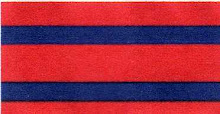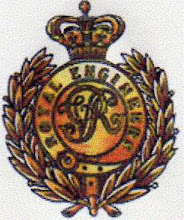1915 – 1919
1st January 1915 – BAILLEFUL – New Years Day.
The Company continued work on the Dranoutre – Lindenhoek trench line, in particular Hill 60, as shown by Lt. Pennycuick’s sketch.

14th January 1915 – DRANOUTRE.
The Company moved back to the Billets at Dranoutre, where daily work was carried out at Wulverghem.
Here low wire entanglements were repaired with the help of 150 infantrymen.
29th January 1915 – BAILLEFUL.
The NCO’s gave instruction to the Infantry Brigade (Reserve), in the use of hand grenades and trench mortars.
5th February 1915 – NEUVE EGLISE.
Move to new Billets at Neuve Eglise, the Company continued trenching in Wulverghem and Lindenhoek.
1st April 1915 - Distinguished Conduct Medals Awarded
According to the London Gazette on the 1st April 1915:
Issue No 4048 - Sergeant Major John Buckle - 59 Field Company RE - "For Gallantry and ability near Richebourg, in directing the work of his section, when erecting wire entanglement close to the enemy position.
Issue No 9321 - Sapper Henry Whitting - 59 Field Company RE - "For conspicious gallantry in persisting in the erection of wire entanglement in front of our trenches, being necessarily exposed to fire from our own side, as well as from the enemy."
5th April 1915 – SUZANNE.
Ypres Field Company moved up to the Somme Company HQ based at Meaulte.
59 Field Company remained in the area of Suzanne for the remainder of 1915, with limited casualties.
5th January 1916 – VAUX SUR SOMME
The Company was taken out of the line and rested for one week.
They were then withdrawn to Pont Noyelles and given tasks, such as tree felling and distribution of wood.
1st March 1916 – ARRAS.
The Company moved to Arras, where they were put under Command of 4 Division.
Here they were used to construct dug-outs.
29th May 1916.
Captain ME Morgan took over Command of the Company.
3rd July 1916 – SOMME.
The Company moved back into the Somme area, where a rotation of work in the following areas occurred:- Houvigneul, Rubempre and Mametz.
The Company remained in this location for some time, engaged in Field Defences such as tunnelling, wiring and communication improvements.
21st March 1917 – ALLOUAONE.
Captain DH Green assumed Command of the Company.
The 4th Division became Army Reserve at Allouaone, where a 2 week training programme was instigated, by the new Company Commander.
1st October 1917.
Under 4 Division orders, the Company was employed laying and maintaining board tracks through Sanctuary Wood and Stirling Castle.
30th November 1917 – Honours and Awards.
Military Cross – 2nd Lt. G. Duncan
Military Medal – Sgt Croucher
Cpl Poland
2/Cpl Garner
2/Cpl Snell
2nd December 1917
Captain D Fitz Maurice took over Command of the Company.
11th December 1917 - March 1918 – LOBIA.
The Company moved to Lobia in Italy.
31st March 1918 – GRENAS.
The Company boarded trains for the return to Grenas in France.
The Company took over work in the left Sub-sector, held by the 5th Canadian Infantry Brigade.
Here the Company was employed in the Morbecque area, constructing footbridges, pontoon bridges and carrying out trench revetments.
June 1918.
The Company was employed on construction of Huts and general shelters along the Divisional line.
August 1918.
The Company move to Nieppe Forset to undertake demolition of bridges.
The Company marches to Haute Visee, then onto Leeds Trench, behind Bucquoy.
Here the Company undertake defence work at night.
Following heavy casualties, the Company undertakes road repairs, post-infantry attack.
31st August 1918.
Captain Brett MacKay Cloutman . Promoted to Acting Major and assumes command of the Company.
6th November 1918.
Acting Major – Cloutman aged 26 yrs, at Pont-sur-Sambre, after reconnoitring the river crossings, found the Quartes Bridge almost intact, but prepared for demolition. Leaving his party under cover, he went forward alone, swam across the river and having cut the “leads” from the explosive charges, returned the same way. The feat was exceptional, given that the bridge and all approaches, were swept by heavy enemy mortar shells and machine-gun fire.
Although the bridge was blown up later that day by other means, the abutments remained intact, a great assistance towards the advance.

5th November 1918 – ARMISTICE.
1st May 1919.
A Cadre of 2 x Officers and 49 other Ranks, returned to Curragh, where Lt. KG McLean assumes Command.
The men of 414 Lowland Field Company join 59 Field Company.
Shortly afterwards, Captain Sharp assumes Command.

